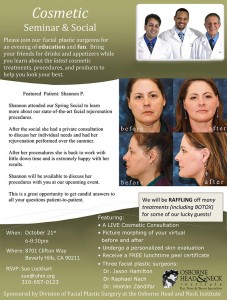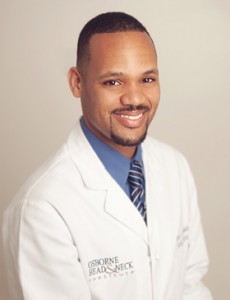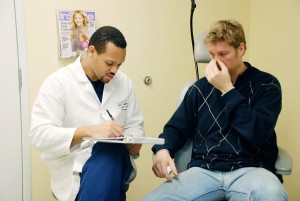- Hereditary Hemorrhagic Telangiectasia - May 25, 2016
- Hereditary Hemorrhagic Telangiectasia: Septal Perforation and Nose Bleeds - May 23, 2016
- Hereditary Hemorrhagic Telangiectasia: Epistaxis and Septal Perforation - May 18, 2016
- Wegener’s Granulomatosis: Autoimmune Disease and Multi-Focal Septal Perforation - May 9, 2016
- Kyle Korver: Facial Injury and Nasal Fracture - March 24, 2015
- Russell Westbrook: Facial Injury and Surgery - March 5, 2015
- Mega-perforation: Pushing the Limits of Septal Perforation Repair - November 26, 2014
- Septoplasty Complication and Septal Perforation - November 24, 2014
- Nose Picking (Rhinotillexis) and Septal Perforations: Why I should stop picking my nose…? - November 24, 2014
- Nasal Fractures, Septal Hematoma, and Septal Perforation: Simultaneous Rhinoplasty and Septal Perforation Repair - October 1, 2014
How do I know if I broke my jaw?
Question: I was recently in a car accident and my jaw hit the side window pretty forcefully. I felt a very sharp pain and was dizzy for a few seconds. I did not end up going to the hospital after the accident but I am now having some difficulty speaking and my jaw feels strange and painful when chewing food. There is also extensive bruising over the lower side of my face. During a phone conversation with a friend, she mentioned that I may have fractured my jaw and that it can be a serious injury. Is it possible that I may have a jaw fracture?
Discussion:
It is a very likely possibility that you have sustained a mandibular fracture as a result of your accident. Mandibular fractures can result from a wide variety of scenarios such as motor vehicle accidents, sporting injuries, assault, or even from a fall. Symptoms of mandibular fracture are variable and depend on the severity of the trauma. Commonly, pain, swelling, and bruising can be observed over the fracture area. Stiffness of the affected area is also a common complaint. Opening and closing the mouth during eating or speaking can also be difficult and painful. Additionally, if a mandibular fracture is severe enough, the alignment of the overlying teeth can be affected. If trauma has damaged the delicate underlying nerves of the face, changes in facial sensation such as numbness or tingling may also be experienced. In some severe circumstances, bleeding can be observed from the floor of the mouth and can potentially become a medical emergency. In all cases of facial trauma and suspected mandibular fracture, prompt evaluation by a qualified facial trauma specialist is recommended.
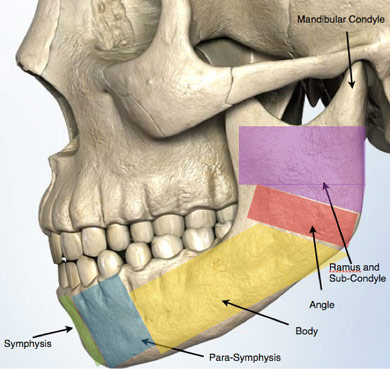
During an evaluation by a facial trauma specialist, a CT scan of the head is usually ordered to determine the presence and location of any fractures as well as any other underlying damage that is not readily evident. Typically, a strong traumatic force can fracture the jaw in one or multiple places along its structure. Depending on the severity of the fracture, multiple treatment options are available. If the fracture is minor and alignment of the teeth and jaw are unaffected, bandaging and observation may be the only intervention necessary. Alternatively, in cases of more complicated fractures or misalignment, the jaw must be stabilized. Stabilization of the mandible can be accomplished by attaching thin undetectable plates directly to the bone fragments. A surgeon places these plates strategically through small incisions made along the gumline, sparing the face from any external scars. In rare occurrences of complicated fracture, a special procedure known as early mobilization is used where the jaw is stabilized with wiring for 10 days instead of the traditional 6-8 weeks. In all cases, a facial trauma specialist is most qualified to advise on a unique treatment plan for your specific injury.
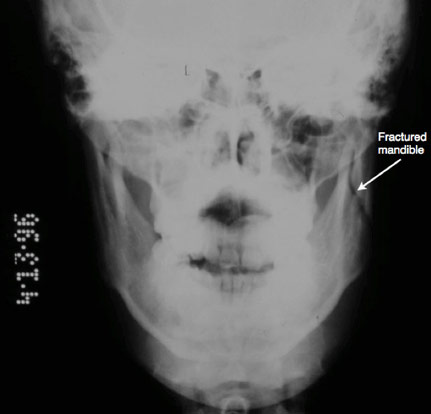
Dr. Jason Hamilton, Director of Facial Plastic and Reconstructive Surgery at the Osborne Head and Neck Institute, regularly evaluates and performs mandibular fracture repair procedures. His unique double board certification in otolaryngology and plastic and reconstructive surgery allows him to address functional and cosmetic concerns at the same time, ensuring outstanding results.
Key Points:
- Mandibular fractures can result from a wide variety of scenarios such as motor vehicle accidents, sporting injuries, assault, or even from a fall.
- Symptoms of mandibular fracture are variable and depend on the severity of the trauma. Common symptoms include bruising, swelling, stiffness, and pain during speaking and eating.
- In cases of severe fractures, issues with alignment of the jaw and teeth may be readily noticeable.
- Facial trauma is commonly evaluated with the help of a CT scan, which can determine the presence of fractures as well as other underlying damage.
- Treatment of mandibular fractures is highly dependent on the severity and location of the fracture.
- Dr. Jason Hamilton’s unique combination of specialties allows him to address both functional and cosmetic concerns when treating mandibular fractures.
To learn more about Dr. Jason Hamilton or mandibular fracture repair, please visit www.facialtraumamd.com.

